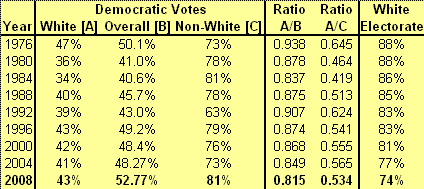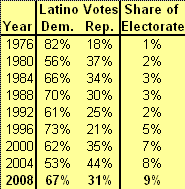The current global financial crisis has proven profoundly resistant to typical Keynesian solutions. Interest rates have been reduced to nearly zero, the money supply is being expanded indefinitely, and fantastic levels of government spending are proposed, yet the stock market continues to fall, investors flock to gold and other safe havens, and banks refuse to extend credit. Whatever merits Keynesianism may have in a crisis of supply or demand, it is not a panacea for every type of economic problem, as was proved by the stagflation of the 1970s. Not all government interventions stimulate production and consumption, nor is it always economically wise for the government to attempt such stimulation.
The current crisis is the product of a burst credit bubble, fueled in large part by U.S. mortgage-backed securities and derivative financial instruments. Most Americans are only able to acquire substantial wealth through equity in a home or other real estate, and this has been facilitated by long-term mortgages, the primary mechanism of home “ownership” in the U.S. since the 1930s. In the last twenty years, a bewildering array of more complicated mortgages, with variable interest rates and even interest-only payments, have made home “ownership” more accessible, resulting in a housing boom. However, many of these mortgages were issued to people who ultimately could not pay, either because their credit risk was ignored or the terms were too complicated and interest rate changes made the mortgage unaffordable. An increase in defaults, combined with a collapse in the value of mortgage-backed securities, further magnified by irresponsible overleveraging in the financial sector, resulted in a crisis where investment banks no longer knew the value of their securities (since these were complex mixtures of many mortgages) and institutions were reluctant to lend. Housing prices fell even more, as the cost of housing in the U.S. had been artificially driven up by the ease of obtaining large mortgage loans, yet homeowners were still obligated to pay according to their original terms. Real estate has ceased to be an effective means of adding wealth, as the long-term value of a home does not appreciate better than the price of gold.
Since Americans have little savings, and many of them have lost their primary means of obtaining wealth, the most rational thing for them to do is spend less and save more. A Keynesian stimulus of consumption would be an irrational demand for people to act contrary to their best interest. Similarly, the burst of the housing bubble and corresponding depreciation of securities is the result of an overvaluation of assets that is now being corrected. It is only natural, therefore, that banks should wish to build up their assets before lending extensively. We should not be surprised, then, that beneficiaries of last year’s Troubled Assets Relief Program (TARP) have done just that. Interest rates were fairly low even before the crisis, and the government has made it known for several months that it will print money ad infinitum if necessary, yet banks still are reluctant to lend. This is because the Keynesian remedy of easy credit and an infinite money supply cannot induce private entities to act against their own interests.
Nonetheless, there is a danger of a vicious cycle, as the rational behavior of banks forces businesses to contract, as they can not rely on as much credit as previously. A contraction in industry raises unemployment, and weakens the basis of the economy, causing further contraction. On the one hand, it is certainly a good thing for businesses to be less dependent on credit, but on the other hand, the optimization of private enterprise depends on a consolidation of capital, which often means large costs up front, requiring lines of credit or some other form of investment. Therefore it would be wise for the government to pursue policies that encourage or stimulate capital investment. Not only is this critical to breaking the downward spiral of consumption and production, but it would also show a commitment to long-term growth. When a government program guarantees long-term benefit to a company, that company will feel secure in expanding its operations, including hiring more employees. People are intelligent enough to realize that a one-time payout will not help them in the long term, so that sort of stimulus will be ineffective, as people will not use the money for capital investment.
Just as the Bush administration failed to recognize that not all tax cuts stimulate growth, so the Obama administration has apparent difficulty understanding that not all spending plans stimulate capital investment. Mr. Obama recently defended his proposed program to upgrade the light fixtures in government buildings as beneficial simply by virtue of the fact that it “creates jobs,” neglecting to realize that even digging a ditch and filling it “creates jobs,” yet has no long-term benefit. A one-time construction project or other government contract will help a company’s balance sheet, but it is not a long-term guarantee, so the company will not make capital investments or permanent expansion in payroll. Good spending programs will specifically finance capital investments: physical plants, engineering research, transportation infrastructure. Government assistance for these investments secures long-term benefit for businesses, and circumvents the current lack of credit availability.
Another means of stimulating capital investment and job creation is to reduce the cost of these through tax cuts. A reduction in the long-term capital gains tax will make it worthwhile for small investors to buy equities, without rewarding speculators. More generous tax exemptions for capital assets will encourage capital investment, and a reduction in payroll taxes would make hiring more affordable, as well as create more long-term disposable income for the working class. Other significant ways to reduce cost include reforming the economically dysfunctional healthcare system (a legacy of 1930s politics and the ill-conceived HMO Act of 1973), and tackling the cost of higher education, a principal source of large individual debt, perhaps by improving secondary education. It is unlikely that the current administration has the mettle to overcome the formidable entrenched interests defending the status quo on health care and education, but Mr. Obama has at least acknowledged that both parties will need to re-evaluate their traditional positions on entitlements.
Determining economic policies is a tricky business, since one can never be sure of a policy’s effectiveness, as we will never know the counterfactual. Economists debate to this day whether the New Deal prolonged or shortened the Depression; there is no way to resolve the question empirically. A national economy is a highly complex, non-linear system, so we should expect it to be unpredictable, and hesitate to equate correlation with causality. Further, it is driven not by mindless, random variables, but by thinking human beings, who may thwart our models. For example, a reduction in interest rates designed to boost investor confidence may eventually have the opposite effect, since everyone knows it is intended to boost confidence, and therefore infer that things must be bad. The surest path to achieving the desired result is to pursue policies that are consistent with what is in the rational economic interest of those to be benefited. If it is in someone’s rational interest to save, do not encourage them to spend. Instead, reward capital investment and other activities that directly improve productivity. Short of a command economy, the swiftest means of implementing an economic policy is to make it conform with what private entities would willingly choose for themselves given the opportunity.

